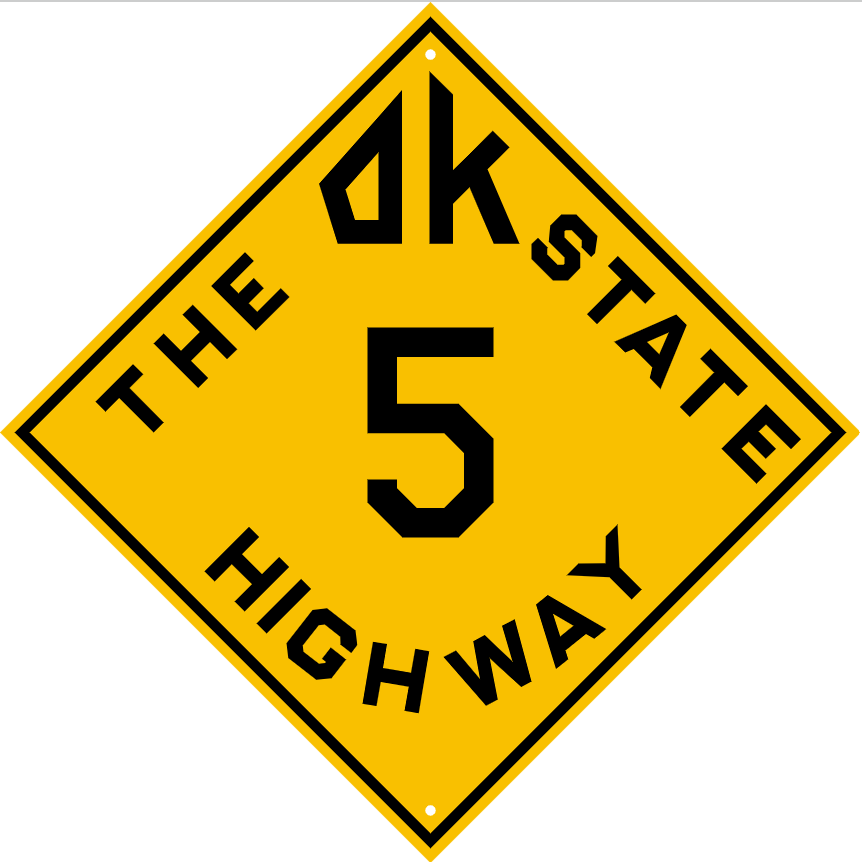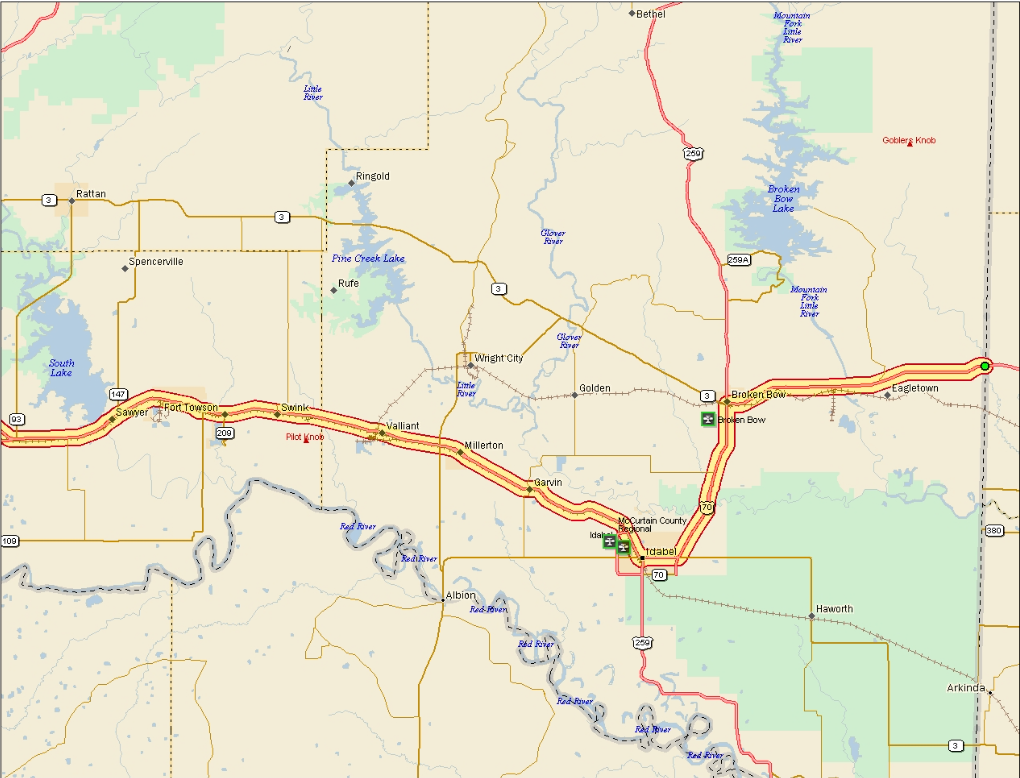Oklahoma State Highway 5, commonly referred to as SH-5, is an integral part of the Oklahoma highway system that spans over 94 miles, traversing through the southern part of the state. It commences at the Texas border near the Red River and extends eastward, terminating at the Arkansas state line. The highway, established in 1932, serves as a primary route to several significant areas, including Walters, Frederick, and Tipton.
The highway’s western terminus is at the Texas border where it connects with Texas State Highway 79 and its eastern terminus is at the Arkansas border where it links with Arkansas Highway 8. Throughout its course, it intersects with numerous other highways, including US-183, US-277, US-70, US-59, and SH-112.
A significant part of SH-5 is a two-lane road, providing a scenic view of the rural landscape of Southern Oklahoma. It weaves its way through agricultural fields, small towns, and rolling plains. However, there are also several sections where the highway widens to four lanes, particularly in areas with higher traffic volumes.
The Oklahoma Department of Transportation is in charge of the maintenance and management of SH-5. They ensure that the road is safe for travel, managing any necessary repairs or improvements. Over the years, the highway has undergone numerous upgrades and realignments to improve safety and efficiency for its users.
Historically, SH-5 holds significance as it was once part of the Ozark Trails, a network of locally maintained roads and highways that predated the federal highway system. Also, it is home to the Tipton Children’s Home, a significant landmark on the highway, which has been providing shelter and care to children since 1928.
In recent years, Oklahoma State Highway 5 has seen some significant developments. For instance, in 2017, a 5.5-mile portion of the highway in Tillman County was reconstructed, improving the road’s safety and efficiency. Similarly, in 2018, a 7.2-mile stretch of the road in Cotton County was rehabilitated and resurfaced to enhance the driving experience of its users.
While the highway is primarily used for local traffic, it also serves as a vital link for regional transportation. It provides access to several recreational areas such as the Great Plains State Park and the Quartz Mountain Resort Park. Additionally, it serves as a critical route for the agricultural industry, with numerous farms and ranches located along its path.
In conclusion, Oklahoma State Highway 5 is not just a road; it is a lifeline for the communities it serves. It is a vital transportation artery that connects people, facilitates commerce, and supports the local economy. Whether one is commuting for work, transporting goods, or exploring the beautiful southern Oklahoma landscape, SH-5 plays an essential role in making these journeys possible. Its continued maintenance and improvement are pivotal to the overall growth and prosperity of the region.

Overview of State Highway 5 in Oklahoma, USA
State Highway 5, also known as SH-5, is an essential artery in the transportation network of Oklahoma, USA. Spanning approximately 81.8 miles, it crosses through multiple counties, connecting numerous towns and cities. Beginning at the Texas state line, it runs eastward until it intersects with US-70, west of Madill. The highway is relatively straight for most of its length, with only minor curves, making it a primary route for locals and interstate travelers alike.
Maintained by the Oklahoma Department of Transportation, the highway is continuously monitored to ensure safe and efficient travel for its users. SH-5 passes through various landscapes, offering scenic views that range from vast plains to hilly terrains. It also traverses through numerous small, rural communities, acting as their primary connection to larger cities and towns. Along the route, travelers can find essential amenities including gas stations, eateries, and rest areas.
While the highway isn’t as significant as larger interstates, it plays a crucial role in the state’s transportation plan. It enables the movement of people and goods, contributing to the economic development of the regions it passes through. Additionally, it aids in emergency services by providing a reliable route for first responders.
Despite its length, SH-5 doesn’t contain any major bridges or tunnels. Instead, it’s a straightforward drive, making it a preferred choice for those seeking a less congested route. The highway does have intersections with other state roads and US highways, which offer alternative routes for travelers.
Overall, State Highway 5 in Oklahoma is more than just a road; it’s a lifeline that ties together numerous communities and facilitates their connection with the rest of the state and beyond. It’s a testament to the importance of transportation infrastructure in promoting socio-economic development and ensuring the well-being of the residents of Oklahoma.
Route Description and Key Features
A route description provides a detailed explanation of a specific path or journey from one point to another. It is vital in the world of travel, tourism, and navigation by offering critical information about the directions, distance, landmarks, and other significant attributes that define the path. The key features of a route description may include the starting point, the endpoint, the distance to be covered, the estimated time of travel, and significant landmarks along the way. Landmarks can be natural or human-made features that are easily recognizable and help guide travelers along their journey. These may include mountains, rivers, buildings, or historical monuments. The description may also specify the type of terrain or road conditions expected, whether it’s a smooth highway, a rugged mountain path, or a winding rural road.
In addition, it may contain information about available amenities along the way such as rest stops, gas stations, cafes, and accommodation options. The route description can also highlight any potential hazards or challenges that may be encountered, such as steep gradients, narrow paths, or heavy traffic areas. This feature is especially important for those planning a hiking or biking trip. Furthermore, any unique or scenic spots that are worth a visit can also be pointed out in the route description. These features not only add interest to the journey but also provide opportunities for rest and relaxation. The goal of a well-crafted route description is to ensure that the traveler is well-informed and prepared for their journey, thereby enhancing their overall travel experience.
Western Segment of the Route
The Western Segment of the Route, often referred to as the West Route, is a captivating stretch of road that traverses through some of the most enticing landscapes and cities in the western United States. This legendary path, which stretches for thousands of miles, offers an enigmatic blend of scenic beauty and cultural diversity that is unmatched anywhere else in the country.
As the route begins in the vibrant city of San Francisco, it quickly delves into the awe-inspiring wilderness of Yosemite National Park, a haven for nature lovers. The route continues eastward, through the deserts of Nevada, where the captivating Las Vegas skyline emerges from the horizon.
Further east, the West Route passes through the picturesque landscapes of Utah, where the dramatic cliffs of Zion National Park and the unique rock formations of Bryce Canyon are among the highlights. The route then arcs northward into the Rocky Mountains of Colorado, where the crisp mountain air and stunning vistas are a welcome contrast to the desert climate.
The West Route continues into the vast plains of Wyoming and Montana, where the rugged wilderness of Yellowstone National Park and the tranquil beauty of Glacier National Park await. The route eventually ends in the bustling city of Seattle, a cosmopolitan hub that encapsulates the spirit of the West Route.
The Western Segment of the Route is not just a path to travel from one point to another; it is a journey through diverse landscapes, cultures, and experiences. Every twist and turn of the West Route reveals something new and exciting, making this one of the most unforgettable road trips in the United States. Whether you are a seasoned road tripper or a first-time traveler, the Western Segment of the Route promises an adventure like no other.
Eastern Segment of the Route
The Eastern segment of the route is a fascinating route that unveils a plethora of spectacular sceneries and cultural experiences. This stretch of the route, often considered the heart of the journey, spans across diverse landscapes, from bustling cities to tranquil countryside, with a fusion of ancient traditions and modern innovations. Each turn reveals a new vista, each stop offers a unique encounter, making the journey as compelling as the destination itself.
The Eastern segment, usually encompassing regions like Eastern Europe, Asia or the Eastern Seaboard of the United States, provides a unique blend of history, nature, and culture. It is not uncommon to find architectural marvels dating back centuries, standing proudly next to sleek, modern constructions. The route interweaves through these structures, creating a tapestry of old and new, a testament to the passage of time and progress.
Nature lovers find the Eastern segment particularly appealing due to the diverse landscapes it traverses. Dense forests, serene lakes, towering mountains, and expansive plains are among the natural wonders that one can witness along the journey. The route is also home to an array of wildlife, offering opportunities for close encounters with nature.
The Eastern segment of the route is more than just a path; it is a cultural immersion. It gives travelers the chance to taste local cuisines, listen to regional music, participate in local festivals, and interact with communities, each with their unique customs and traditions. It offers a rare glance into the everyday lives of the people residing along the route.
In conclusion, the Eastern segment of the route is a journey of discovery, a chance to explore the richness of various landscapes and cultures. It is a route that invites travelers to step out of their comfort zones and delve into the unknown, promising an unforgettable experience.

Spur Routes and Connections
Spur routes and connections typically refer to the supplementary routes that branch off a major highway or railway line, which primarily serve to provide access to specific towns, cities, or regions that are not directly on the main route. These routes are commonly designated by adding a suffix or prefix to the number of the parent route, helping travelers identify their linkage to the primary route. For instance, if a primary Interstate Highway is numbered I-80, a spur route off this highway might be designated I-180 or I-980.
These routes and connections play an integral part in the transportation infrastructure, often serving as critical links between smaller communities and larger transportation networks. They ensure efficient movement of people and goods, which can significantly contribute to the economic development of the areas they serve. Spur routes also play an essential role in reducing traffic congestion on main routes as they can divert traffic away from busy sections of the highway or railway network.
In the railway industry, spur lines or sidings are short, secondary tracks that allow trains to be parked while others pass, facilitate loading and unloading, or provide additional capacity for rail cars. They allow for more efficient use of the mainline and can increase the overall efficiency of the rail network.
In the aviation industry, spur routes might refer to smaller routes that branch off a primary airway. These routes are often used to service smaller airports that are not located directly on a main airway. Like their highway and railway counterparts, these airway spur routes allow for more efficient use of the airspace and can contribute to safer and more effective air traffic management.
In conclusion, whether on the road, rail, or air, spur routes and connections are fundamental to the efficient functioning of our transportation networks, ensuring accessibility and contributing to economic growth.
List of Junctions and Intersections
Junctions and intersections are integral parts of road networks across the globe, serving as points where two or more roads meet or cross. They play a crucial role in traffic management, facilitating the smooth movement of vehicles, cyclists, and pedestrians. There are several types of junctions and intersections, each with unique characteristics and functions.
The most common type is the four-way intersection, where two streets cross each other at a 90-degree angle. Another familiar type is the T-junction, which occurs when one road ends at another, forming a T shape. More complex intersections include roundabouts, where traffic circulates around a central island, and crossroads, where two or more roads meet at a single point.
In addition to these, there are Y-junctions, where a road forks into two, and diamond interchanges, which are typically found on freeways and highways. These allow for free-flowing movement of vehicles, reducing congestion and improving traffic flow.
Other less common but equally important types of junctions and intersections include the diverging diamond interchange, which is designed to increase capacity and reduce conflict points, and the single-point urban interchange, which allows for a large volume of traffic to pass through a relatively small area.
In recent years, the concept of ‘complete streets’ has gained popularity. This approach considers all users of the road, including pedestrians and cyclists, when designing intersections and junctions. This has led to the introduction of pedestrian scrambles, where pedestrians can cross in all directions while vehicular traffic is stopped, and bike boxes, which provide a safe space for cyclists at the front of traffic queues.
In conclusion, the list of junctions and intersections is vast and diverse, each designed with the specific purpose of facilitating the efficient and safe movement of road users. They are key elements in road infrastructure that contribute significantly to traffic management and the overall transportation system.

Junctions in the Western Segment
The western segment is characterized by numerous junctions that play an integral role in streamlining traffic flow and ensuring seamless connectivity between various points. These junctions serve as strategic intersections that facilitate the efficient movement of people and goods across this region. They are designed with meticulous precision to accommodate diverse modes of transport, including cars, buses, and bicycles, among others, thereby contributing significantly to the overall transportation system’s robustness.
The junctions in the western segment also provide essential links to key infrastructures like schools, hospitals, and shopping centers, enhancing accessibility and convenience for the residents. Moreover, these junctions support the smooth operation of public transportation services, playing a vital role in promoting sustainable urban mobility. They are meticulously managed and maintained to ensure their functionality and safety at all times.
Furthermore, the junctions in the western segment are embedded with advanced traffic management systems to monitor and control traffic flow, reducing congestion and travel times. They are also equipped with pedestrian crossings and cycle paths to ensure the safety of vulnerable road users.
In addition, these junctions are not just about functionality. They are often aesthetically designed, adding character to the western segment’s urban fabric. They sometimes feature public art installations, green spaces, and architectural elements, contributing to the region’s visual appeal.
In summary, junctions in the western segment are more than just intersections. They are crucial nodes in the transportation network, driving connectivity and mobility. They contribute to the region’s socio-economic development by facilitating the efficient movement of people and goods, supporting public transport, and enhancing accessibility to essential services. At the same time, they add aesthetic value to the urban landscape, making the western segment a vibrant and dynamic place to live, work, and visit.
Junctions in the Eastern Segment
The Eastern Segment is renowned for its complex network of junctions that offer a bewildering yet fascinating maze for both residents and visitors. This infrastructure maze consists of various types of junctions, including but not limited to roundabouts, T-junctions, Y-junctions, and crossroads, each designed to regulate and streamline the flow of traffic. Each junction in the Eastern Segment operates on a distinct set of rules that drivers must follow to maintain order and safety on the roads.
The area’s junctions present a litmus test for drivers, challenging their knowledge, adaptability and driving skills. Navigating through this network requires a profound understanding of road signs and markings, which guide drivers on speed limits, right of way, and turning rules. The roundabouts, for instance, require drivers to give way to vehicles coming from their immediate right, whereas at T-junctions, the driver on the terminating road must yield to vehicles on the cross road.
The junctions in the Eastern Segment are not only about managing vehicular traffic. They also have pedestrian crossings and bicycle lanes, ensuring safety for all road users. The crossings are equipped with traffic lights and audible signals for visually impaired pedestrians, while the bicycle lanes are clearly marked, separated from the main roadway for safety and convenience.
Despite the seeming complexity, the junctions in the Eastern Segment are well-managed. The local authorities have invested heavily in traffic management systems, including the installation of advanced traffic lights, surveillance cameras, and digital signages to enhance the efficiency of the junctions. This has resulted in a smooth flow of traffic, even during peak hours, reducing congestion and travel times.
In conclusion, the junctions in the Eastern Segment serve as a crucial element in the area’s transportation system. They are designed and managed with the intent of ensuring a smooth and safe travel experience for all road users.